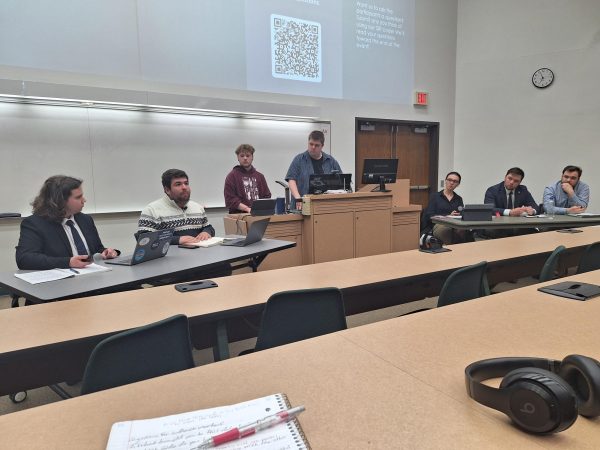Coronavirus: Wisconsin case elicits concern
UW-Eau Claire Health Services respond to virus outbreak
More stories from Evelyn Nelson
Photo by Evelyn Nelson
Through a person-to-person case, the novel coronavirus can spread within a close proximity of six feet. This transmission occurs through respiratory droplets, most often when an infected person coughs or sneezes.
A cough, sneeze or even sharing a drink of water. These everyday occurrences have brought attention to a global medical crisis, as the COVID-19 outbreak continues.
According to the Centers for Disease and Control Prevention, the strand of coronavirus, which is caused by a virus called 2019-nCoV, was first identified in Wuhan, Hubei Province, China on Dec. 31.
The novel coronavirus is a respiratory illness, with the most common symptoms being shortness of breath, a repeated cough and a high fever. These symptoms may appear in two to 14 days following the initial exposure, according to the CDC.
The coronaviruses, actually a large collection of viruses, spread from a variety of animal species to humans.
However, the 2019 novel coronavirus is under investigation on alternate modes of transmission — specifically from human to human.
In a person-to-person case, the spread happens within a proximity of six feet. This transmission occurs through respiratory droplets, most often when an infected person coughs or sneezes, according to the CDC.
Patricia Kress, physician and medical director of the UW-Eau Claire Crest Wellness Center, said with the potential risk of misunderstanding the differences between a coronavirus and influenza, a difference in age is where the severity of each virus is emphasized.
“The concern with the coronavirus, though, is because of what it does to people that are older than 65 with health conditions,” Kress said. “We need to stop it in young people, too, because they can spread it to their elders or older people.”
In more severe cases of the outbreak, the infection may result in pneumonia, acute respiratory system, kidney failure and death, according to the World Health Organization.
A variety of news outlets continue to release updates on the virus, each with its own method to help larger audiences understand the technicalities of the coronaviruses.
The WHO released a collection of video uploads to explain the novel coronavirus through a visual medium.
In anticipation of the Spring 2020 semester, the UW-Eau Claire Department of Risk Management and Safety sent out a campus-wide email and addressed the coronavirus concern on Monday, Jan. 27.
The email was in a “Frequently Asked Questions” format about the virus and it outlined recommendations the Eau Claire Health Services provided to prevent further outbreaks.
Timothy Boehnen, the director of Risk Management and Safety, said the coronavirus and other illnesses have been given the attention they deserve to establish long term solutions.
“This is something that we want to be monitoring and aware of to make sure that we protect our entire campus community,” Boehnene said. “Our students, our faculty, our staff and our community. It is very important to remember that even with all the latest reports, the CDC still considers this a very low risk to the United States and the university.”
An updated email from the Department of Risk Management and Safety was sent out on Friday, Jan. 31.
The updated email addressed where the most recent coronavirus cases were located across the nation, alongside whatever information the university could share regarding the international student body on campus.
According to WEAU News, the first Wisconsin coronavirus case was found announced on Wednesday, Feb. 5.
This case is now confirmed as the 12th coronavirus case nationwide, according to CBS.
The patient is currently in isolation, but Wisconsin state health officials will not confirm their location, age or other personal details, according to WEAU News.
Kress said her role involves educating people about the different forms a coronavirus can take within a sick individual.
“The four ones out there that normally attack humans, so to speak, or lead to illness in humans, cause basically the common cold,” Kress said. “Ten to 15 percent of the time when you have a stuffy nose and a cough, it is a coronavirus. This one is a little different in the sense that it actually is coming from animals to humans instead of human to human. And so it’s a different strain. And right now, if you are young and healthy, it will just cause a general bad cold.”
Kress said the university has already commenced a “preparedness stage” toward the virus outbreak to provide preventative measures on how to go about the common symptoms of the virus.
“When you get the virus — if you touch a doorknob and then touch your face — then you could transmit from what we call a touch point — to your mouth or eyes — and then you could get the virus,” Kress said.
Kress said her role helps educate the campus community on the misconceptions of the novel coronavirus, as many individuals are concerned with the risk of death from the virus.
“If you are young and healthy, (the coronavirus) will just cause a general bad cold,” Kress said. “If you are elderly with other illnesses like diabetes or heart failure, then you are at more risk for it to become pneumonia. Those are usually the people that are more at risk of dying.”
Kress said the main concern toward viruses is the exposure onto others. She hopes to reduce the stress UW-Eau Claire students may have about the novel coronavirus and other illnesses that impact them more directly.
“The influenza out there right now is much more contagious and it actually makes the younger people more sick because you are getting (additional symptoms) of achy muscles and a higher fever, usually,” Kress said. “I would say getting influenza is almost harder on you than getting this coronavirus if you are a young, healthy person.”
The spread of a coronavirus or similar illnesses can occur within a shorter distance, Kress said, so for college students, a classroom environment is a hotspot.
“We don’t want to spread it on to anyone else, you want to stop the spread,” Kress said. “If you are (contagious and) in a class with 30 people, you could pass it on to 30 people. You do need to be within three to six feet of someone for 10 minutes or more as a general rule to be considered.”
Boehnen said the Department of Risk and Management Safety upholds a flow of responsibilities from a national-to-statewide level through the Wisconsin Department of Health and Safety when facing issues like infectious diseases.
“The vast majority of tests being done within Wisconsin — specifically according to the press release from the DHS — have been showing negative results, which is really good,” Boehnen said. “The Eau Claire county Health Department is the lead agency that we are in communication with on a daily basis for updates.”
Kress said the staff through Student Health Service have been trained to evaluate and screen students who are concerned they may have been exposed to the coronavirus.
“If we do think it is the coronavirus, we do need to put on goggles and a special N-95 face mask, which is more than a surgical mask,” Kress said. “We gown and we glove and take extra precautions for the students coming in if they think they have it.”
Bohen said recent media reports have generated a misconception that China and people who have recently visited there should be subjected to judgment or mistrust around the coronavirus.
The Department of Risk Management and Safety will work on keeping the public up-to-date, as well as inform the public on the global effects the virus has.
“It is important for people to understand that China is simply the point of origin,” Boehnen said. “It really is a worldwide emergency with not just one demographic. That is one of the biggest things to take away.”
Nelson can be reached at [email protected].











